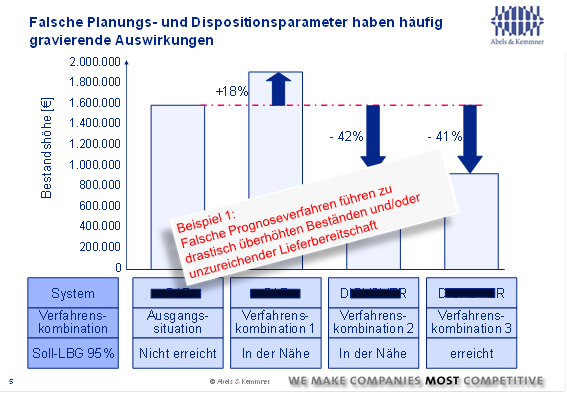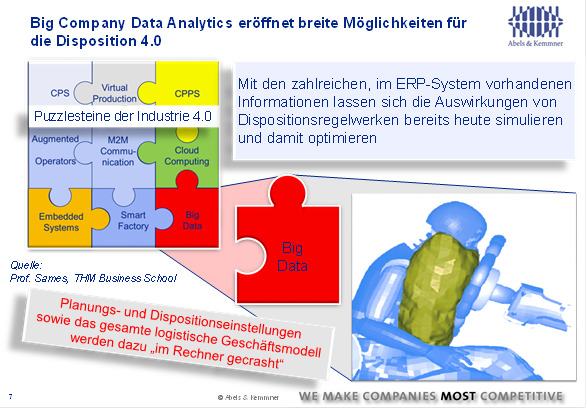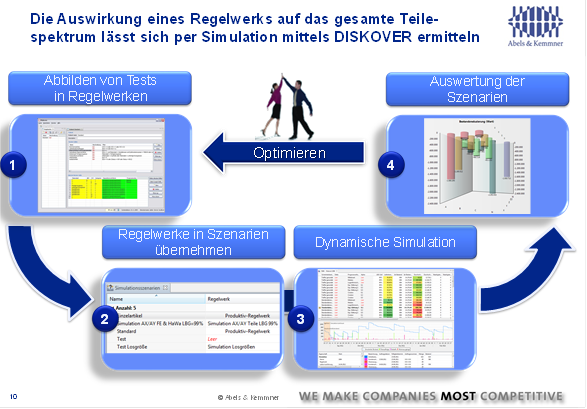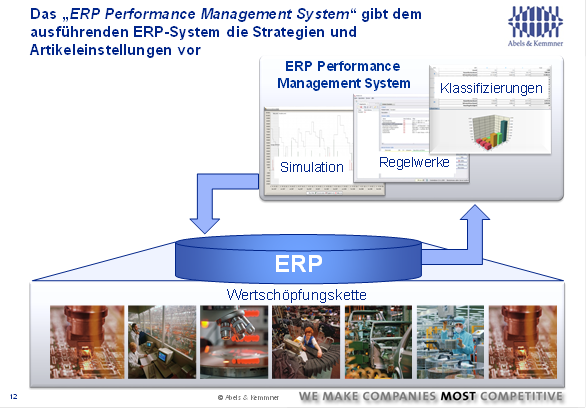By Prof. Dr. Götz-Andreas Kemmner and Prof. Dr. Gerrit Sames1
The implementation of a Factory 4.0 concept also requires “Scheduling 4.0”. In the following, we will explain why this is the case and what Disposition 4.0 means. We will see that Disposition 4.0 is not just a vision, but is already a reality for technology leaders.
Today, we are on the threshold of a new automation push in industry, commonly referred to as “Factory 4.0” or “Industry 4.0”. From a strategic perspective, “Industry 4.0 […] aims to enable German industry to be equipped for the future of production”. Specifically, it means achieving “production advantages through networked, flexible and dynamically organized production for highly customizable products”. Two further buzzwords are seen as essential technological foundations of “Factory 4.0”: Cyber-physical systems and the “Internet of Things”.
In order to be able to manufacture the models and products of the future, the industry cannot avoid making its structures and thus its disposition fit for the future. The first companies are already involved.
Put simply, both terms refer to the independent communication between different components (software, mechanical and electronic elements) in the production chain, value chain and supply chain.
The ideas behind Factory 4.0 have the air of purely decentralized structures that no longer have to obey a common plan. The component “talks” to the machine tool about which new material it wants to be processed into and finds its own way through the factory and through the various storage stages. The machine tool independently places an order for the tools it requires in the ERP system. However, higher-level central specifications are also required in Factory 4.0, as parts must be kept in stock and production orders must be scheduled. The following two examples make this clear:
- Even if production material will find its way through the factory autonomously, a decision must be made as to when it will be sent on its way;
- In order for an ERP system to order parts automatically, reliable decision-making mechanisms must be established.
The Factory 4.0 also urgently needs an MRP 4.0.
Mechanisms for Disposition 4.0 already exist, but they are only being used by a few performance leaders. The main challenge and therefore the decisive key to MRP 4.0 lies in the intelligent evaluation of the enormous amounts of data that are available in today’s ERP systems due to the increasing digitalization of processes and are constantly growing.
Let’s take a look at the current situation in this regard:
With the increasing digitalization of processes, companies are generating more and more data. This applies equally to data from production processes and data from administrative processes.
Unfortunately, the systematic collection and analysis of the data is still underdeveloped and little or no conclusions are drawn from the data. What is important here is that the data analytics fit the questions very precisely and must therefore be designed very specifically, as we will see in more detail later. Intensive work is being carried out on suitable mathematical methods and algorithms to filter information from the data volumes and the first practical solutions already exist.
Scheduling is the heart of every company.
It is easy to understand why the enormous amounts of data and their intelligent evaluation are so crucial for MRP 4.0 if you realize the following: MRP is the heart of every company, pumping the entire material flow through the supply chain and value chain. This is why the quality of scheduling is of crucial importance for the profitability of a value chain. The quality of scheduling, in turn, depends on the scheduling parameters, as they play a decisive role in determining how stocks, delivery readiness, ranges, capacity utilization and throughput times in procurement, production and distribution develop and how economically the entire value chain works.
Many companies have not achieved the economic effects they had hoped for from their ERP system.
In today’s Factory 3.0, there is already a lack of effective scheduling: many companies are finding that, despite the use of ERP systems, the desired reduction in inventory, for example, is not materializing. Planned delivery readiness levels were also not achieved. Our companies are well aware of the main reasons why ERP targets are not met: Maintenance of MRP parameters often does not take place or only at too great intervals. First of all, this is due to the excessive manual maintenance effort and thus time required for data maintenance. However, even in companies where a certain amount of maintenance is carried out, the quality of the scheduling parameter settings is usually poor, because on the one hand far too few parameters are considered and on the other hand these are usually still set to the best of the responsible scheduler’s knowledge.
No great visions are needed to recognize that the challenges will continue to grow. The time available to dispatchers for data maintenance will inevitably become less and less; demographic trends alone will lead to an increasing shortage of the necessary personnel. But what is probably even more decisive is that users’ understanding of the effects of dispensing parameters is very limited, especially as even proven experts can no longer reliably understand their complex interaction. Ultimately, ERP systems generally do not provide suitable tools for optimizing scheduling parameters.
Although many managers recognize that the data quality in the ERP system is not satisfactory, they still doubt that much can be achieved by readjusting scheduling parameters. However, the correct or at least improved setting of the disposition parameters is not about tuning an engine that is already sufficiently powerful and then trying to tease the last bit out of it, but about getting an engine to run properly in the first place. The following practical example from an international production company may illustrate this (see Fig. 1).

This example shows how drastically different process settings can affect stocks and delivery readiness. The aim of the division was to ensure 95% delivery readiness to the market. The stocks required for this should be kept as low as possible. As the figure shows, by adjusting the ERP system’s scheduling parameters appropriately (process combination 1), it was possible to adequately ensure delivery readiness, albeit at the cost of an 18% higher inventory level. Thanks to further optimizations, supplemented by extended scheduling and forecasting functionality, the required delivery readiness was ultimately achieved with 40% less stock (process combination 3).
Before we talk about how to arrive at such numerical values without having to test them empirically for months or even years, we would like to summarize once again why the conventional maintenance of disposition parameters does not lead to success.
Firstly, conventional maintenance of scheduling parameters is far too time-consuming.
Imagine you were responsible for 1000 items and wanted to concentrate on maintaining the 10 most important scheduling parameters. You want to view these four times a year, i.e. once every three months. It is certainly no exaggeration to assume a time expenditure of 60 seconds per MRP parameter, because each material number has to be called up, the masks with the desired parameters have to be loaded and the correct setting has to be thought about or looked up. If you add everything up, you arrive at a maintenance requirement of 666 hours per year. This corresponds to approx. 40 percent of your annual work capacity.
Secondly, conventional maintenance of scheduling parameters does not deliver reproducible scheduling results.
Every practitioner is aware of this effect, but most companies do little to counteract it. Every user weighs facts differently, behaves differently and only has an overview of part of what is happening. With every vacation or sickness replacement, with every change of personnel, the disposition world of the affected articles changes, which in turn has an impact on all subsequent disposition levels.
Thirdly, conventional maintenance of scheduling parameters does not deliver economically optimized results.
Economically optimized scheduling results cannot be achieved by gut feeling, because the interaction of the various scheduling settings is extremely complex. Ultimately, it is about statistical effects and statistical correlations between parameter settings and economic results.
Even if you only assume 10 parameters that are important for the performance of an article, as in our example of the time required for data maintenance, no one can assess the logistical interaction of these parameter settings and thus their economic impact.
In powerful ERP systems, however, far more scheduling parameters can be set for each material number. In the SAP® system, for example, up to 130 parameters can be defined for each material; this does not even include settings for historical values, quotations, scheduling agreements and contracts. Of course, nobody needs that many settings for an article at the same time, but in practice there are always far more than 10.
At first glance, it seems difficult to achieve correctly set disposition parameters under these circumstances.
Big Company Data Analytics opens up a wide range of possibilities for scheduling 4.0.
However, the DISKOVER SCO tool is the first Factory 4.0 solution on the market that is able to use the extensive data in the ERP system to determine optimized parameter settings and continuously readjust certain scheduling parameters (see Fig. 2). “Big data is when insights into reality can be gained from a large amount of data that could not have been gained from a smaller amount,” as Viktor Mayer-Schönberger put it. The DISKOVER system is used to analyze this large amount of data stored in ERP systems.

At the heart of the analysis are simulations that are used to check how a certain combination of scheduling parameter settings affects the profitability of the scheduling results. Simulation approaches are used in many areas today. Vehicle bodies are ‘crashed’ in the CAD system during development and optimized based on the simulation results. The same applies to the development of molds for shaping production processes such as casting, forging or injection molding. In these cases, too, the flow of the material is simulated during injection into the mould in order to optimize the shaping. The DISKOVER system ‘crashes’ the scheduling in the computer, so to speak, before the parameter settings are implemented in practice.
The simulation process does not replace the expert who can interpret the simulation results and draw conclusions from them. However, optimization processes are drastically accelerated, risks are significantly reduced and far better quality results are achieved. On the one hand, the simulation results can be mapped in scheduling rules. On the other hand, particularly dynamic parameter settings, such as safety stocks or forecast values, are directly readjusted by simulation processes.
It is also very interesting that it is possible to check directly for each individual article and each material whether the required delivery readiness levels can actually be met in practice and which approximate target stock levels can be achieved.
In the following, we will take a closer look at how such a simulation approach works in practice.
The basic data analysis and simulation process can be divided into five steps:
- Appropriate methods can be used to calculate stock trends, delivery readiness levels and ranges of coverage from stock inflows and outflows.
- Simulations with variations in dispatching parameters and scheduling strategies can be used to calculate target ranges of coverage or the number of vehicles to be dispatched. The degree of readiness for delivery can be determined.
- With which settings, under which boundary conditions, optimized stock heights, ranges of coverage resp. The degree to which delivery readiness levels are achieved is mapped in decision tables and regulations.
- The rule-based setting parameters are fed back into the ERP system; manual maintenance of dispensing parameters is therefore no longer necessary.
- The results are optimized and fed back into the ERP system automatically on a daily basis or at selectable times.
In order to simulate the effects of alternative scheduling settings for different article groups, scheduling parameter settings or entire sets of rules to be tested are transferred to scenarios in the DISKOVER system and fed into the simulation process. The results can be viewed directly in DISKOVER as an overall result for all articles as well as for each individual article in order to obtain information for optimization approaches. In this way, different alternative courses of action can be played through and compared with each other (see Fig. 3).

The result of the data analyses is not only information on the correct parameter settings in the ERP system, but also strategic insights and organizational rules, which we do not want to deal with here, although they can be of great importance for corporate strategy. Of direct importance for scheduling 4.0 is how to deal with the technical findings with regard to scheduling rules in order to be able to apply them effectively and efficiently in practice.
A central task of Dispo 4.0 systems is ERP performance management.
The “Dispo Manual” of the 1990s or simple work instructions are no longer enough. This is not only because it would be far too time-consuming for users to look up the rules in order to maintain the data. More importantly, the regulations are based on a large number of different material classifications that have to be constantly recalculated and without which the regulations would not work. Rather, the consistent implementation of MRP 4.0 requires a strategically oriented tool that specifies the current MRP parameter settings to the ERP system and thus optimizes logistics performance – you could call it a “ERP Performance Management System” or simply call it the “Dispo 4.0 system” (see Fig. 4).

Such an ERP performance management system / Dispo 4.0 system readjusts the parameter settings in the ERP system. It must
- transfer a wide range of basic data from the ERP system;
- carry out numerous item classifications and key figure determinations;
- rules and decision tables;
- have extensive simulation functions, and
- return the setting specifications to the ERP system.
There are already various solutions on the market for classifications and simple sets of rules. Today, the wheat is separated from the chaff when it comes to simulation functions.
Even if the market is still thin on the ground, ERP performance management based on “big company data” has arrived in practice and is already being used by technology leaders. This is illustrated by the examples of three companies that have made great progress in this area:
- Hansaflex AG, one of the world’s leading suppliers of hydraulic systems, manages around 400 regional warehouses practically fully automatically. Demand forecasts, warehousing and scheduling strategies are specified by DISKOVER to the SAP® system by means of automatic simulation and a differentiated set of rules.
- Trost SE, one of the leading automotive parts wholesalers in the independent aftermarket in Germany and Europe, manages the scheduling of its two central warehouses and approximately 150 branches in Germany, Austria, the Czech Republic, Slovakia and Romania using the planning and scheduling rules also defined in the DISKOVER system.
- The STO Group – a leading international manufacturer of paints, plasters, varnishes and coating systems as well as external thermal insulation composite systems – uses the DISKOVER EPM system to control the replenishment of its branches in Germany and Switzerland in order to specify optimized replenishment strategies to the SAP® system using rules and simulations under economic efficiency criteria.
In all three cases, significant inventory reductions, improved delivery readiness and more efficient scheduling processes were achieved. All three companies see the introduction of the Dispo 4.0 system as a strategic investment in increasing their competitiveness and profitability, which is why we have to keep the improvements achieved confidential.
In our companies, we will not be able to avoid developing our value chains in the direction of Factory 4.0. However, we don’t necessarily have to start with communication on the store floor. It is precisely there that extensive prerequisites must first be created, which are associated with major investments. Investments that can only become effective to a considerable extent once other prerequisites, such as MRP 4.0, have been realized. By taking a step towards MRP 4.0, we are not only laying an essential foundation for Factory 4.0, but also generating the income with which we can finance our Factory 4.0 strategies.
1Prof.Dr.-Ing. Dipl.-Wirt.-Ing. Götz-Andreas Kemmner is Managing Partner of the management consultancy Abels & Kemmner GmbH and Honorary Professor of Logistics and Supply Chain Management at the West Saxon University of Applied Sciences in Zwickau.
Prof. Dr.-Ing. Gerrit Sames is a professor of general business administration, in particular organization with a focus on ERP systems at the THM Business School in Giessen. He previously held management and board positions at the Monier Group, Schott AG and Buderus Heiztechnik GmbH.
2http://www.softwaresysteme.pt-dlr.de/de/industrie-4-0.php
3http://www.siemens.com/innovation/de/home/pictures-of-the-future/industrie-und-automatisierung/digitale-fabrik-industrie-4-0.html [Leider hat SIEMENS diesen Beitrag von ihrer Webseite genommen.]

